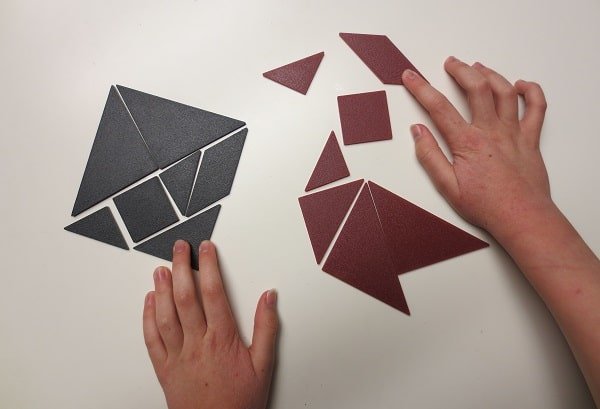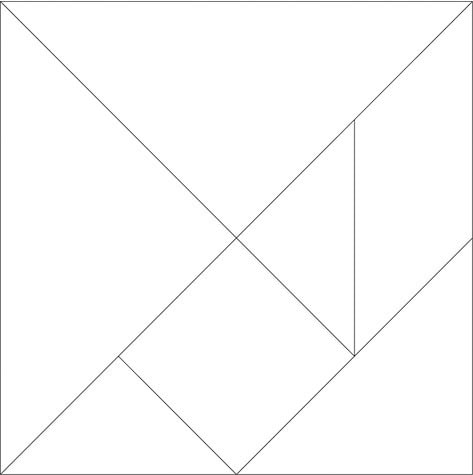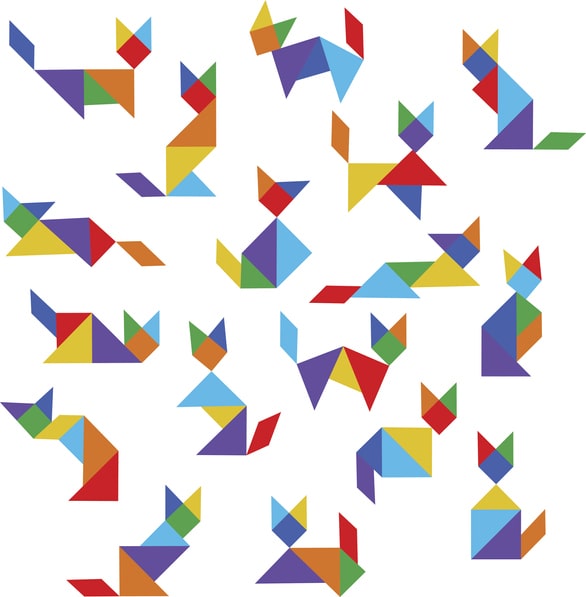
Tangrams for children: A finding out device for building STEM abilities
Like constructing blocks , tangrams can show kids regarding spatial connections. They might help children find out geometric terms, and establish stronger trouble resolving abilities. They might even assist kids perform better on examinations of standard math. Yet what is a tangram?
Developed in China about 200 years back, a tangram is a two-dimensional re-arrangement puzzle produced by reducing a square right into seven items– 7 geometric forms called “tans” (Slocum et alia2003
What are the 7 forms in a tangram? Each tangram puzzle has the following:
- 2 huge right triangles
- 1 medium-sized ideal triangular
- 2 tiny appropriate triangles
- 1 little square
- 1 parallelogram
Prepared properly, these tangram forms can be fitted together as a big square, rectangle, or triangular. They can additionally be organized in a range of intricate forms, including extravagant ones.
There are many methods to have fun with tangrams. The simplest means is to allow youngsters create their own complicated shapes. But traditionally, tangrams are dealt with as problems, where players are challenged to duplicate particular styles. And there are rules.
The classic guidelines
The classic policies are rather simple. To count as a conventional remedy, players should satisfy the following requirements:
- a finished style must use every one of the tangram pieces;
- every item must touch at the very least one other item, even if it’s simply the peak of an edge contacting an additional piece; and
- all of the pieces should lie flat, with none overlapping each various other.
Likewise, in the standard, traditional strategy to the problem, the player is revealed a target shape in summary just, to ensure that the “joint” between the composite tans are hidden. Then the player tries to recreate the form using the 7 items.
In essence, it’s a workout comparable to organized block play , where the challenge is to create an exact duplicate of a structure illustrated in a diagram. However there’s a key difference.
In organized block play, the representation provides you with explicit, aesthetic information concerning where each item goes. With a tangram challenge, you’re delegated figure that our for yourself.
As kept in mind by Zhen Yuan and his coworkers, fixing tangram puzzles shows up to trigger parts of the brain associated with creative thinking and trial-and-error problem-solving (Hu et al2019
What makes tangrams especially challenging?
One of the most tough challenges are called timeless, “silhouette puzzles,” where gamers can’t see the internal lines specifying the tans that comprise a service. In the picture below, the center row of tangrams are shape puzzles. The other rows supply gamers with specific hints concerning the interior framework of each problem.


We can make things less complicated for gamers by supplying them with lines or shade hints as detailed over. However also then, beginners– especially little ones– may have difficulty matching the layout. Challenges commonly call for the player to orient shapes in non-standard methods. You might need to turn or turn a piece to make it fit.
It’s not unusual for youngsters to picture certain shapes with a really specific alignment in mind. For example, pupils might think of a square not merely as a figure with four equal sides, but as a number that “rests” flat along the straight aircraft (see photo listed below). If the square is slanted from this positioning, youngsters might not analyze it as a square any longer. Currently it’s a ruby (Clements and Sarama2014
This suggests that players might be slow-moving to recognize the tan they require, even if the form is right in front of them. If it’s not already oriented in a manner that parallels the target alignment, they could not make the psychological connection.
No surprise, after that, that finding out to transform and turn forms is frequently a major advancement for gamers. It assists them reinterpret exactly how pieces can mesh (Bofferding and Aqazade2023
What are the educational advantages of tangrams?
When we play with tans, we consider the forms from a range of angles and viewpoints. How would certainly the forms look if we stuck them together? Rotated them? Slide them around into various settings?
Experiments recommend that thinking of such points– envisioning the spatial partnerships between forms in your “mind’s eye”– can boost our visual-spatial skills.
Research tips that it can enhance math performance, too. When Yi Ling Cheng and Kelly Mix asked kids, aged 6 – 8, to execute a series of tangram-like spatial tasks, the session seemed to prime the brain for maths.
Children who spent 40 mins resolving shape rotation problems done better on a pencil-and-paper arithmetic examination immediately afterwards. Contrasted to tangram-like activities, crossword puzzle warm-ups had no such result (Cheng and Mix2012
So there is factor to presume that playing with tangrams has educational benefits, and many instructors recommended their usage in the class (Bohning and Althouse 1997; Krieger 1991; National Council of Teacher’s Math 2003; Clements and Sarama2014
In particular, these educators say that playing with tangrams may help youngsters
- identify forms
- develop favorable sensations regarding geometry
- acquire a more powerful understanding of spatial partnerships
- develop an understanding of how geometric shapes can be broken down
- hone spatial rotation skills
- acquire an accurate vocabulary for manipulating forms (e.g., “flip,” “rotate”)
- discover the meaning of harmony
In addition, researchers have actually said that tangram play can be an opportunity for kids relocate far from simple (and inaccurate) ideas about shapes. Young children, for instance, could battle to clarify what functions are required for a form to be a square. With guided questioning, an educator can assist children establish why some attempts to make a square with tangrams are unsuccessful (Nic Mhuirí and Kelly2021
Kids can also discover new vocabulary to describe the forms they assemble (e.g., rhombus, trapezoid, hexagon). And Tom Scovo shows how tangrams can assist children compute areas without formulas. For the information, see his outstanding activities utilizing tangrams for youngsters in grades 4 – 6
What about cost-free play with tangrams? That’s great, as well. Yet bear in mind: Kids most likely stand to discover a lot more if their play includes discussion and synergy.
Certainly, research studies show that spatial play– like having fun with tangrams– is especially academic when children interact with others that use spatial vocabulary.
As an example, kids tend to develop bigger spatial vocabularies if, during play, their parents subject them to a greater range of spatial words, like “triangle” and “line.” As I clarify somewhere else, such youngsters are additionally more likely to create stronger spatial abilities.
So it’s most likely we can improve the value of tangrams by proactively engaging youngsters in discussion. We can introduce them to words they may not understand, like “angle” and “parallelogram.”
It’s also likely that children will certainly take advantage of being asked to make forecasts and discuss strategies.
Study suggests that children are more probable to understand ideas when they explain them to others. What will take place if you rotate the triangle? What will take place if you flip the parallelogram? Exactly how must we move this form in order to make it fit?
If we can obtain kids to discuss their ideas, we might assist them improve their spatial abilities and comprehension of geometry (Lee et alia 2009; Clements and Sarama2014
So while children may benefit from solitary play with tangrams, a few of the best instructional experiences may arise from having fun with a (talkative) companion.
Any type of other training pointers?
Tangrams offer children an exceptional possibility to check out various geometric adjustments, and become accustomed to the buildings of the shapes they make use of.
Yet observe the triangles– large, medium, and little– are all the same shape. They stand for a special type of ideal triangle– an isosceles triangular with two 45 -level angles, and one 90 -degree angle. And if you put together 2 triangles of the same size, you can make a square.
These residential properties aren’t found in all triangulars. As a matter of fact! However it’s easy for kids ahead to that conclusion if they do not obtain revealed to a range of triangles– equilateral, isosceles, and scalene. So it’s important to subject youngsters to that selection, and call their focus to the ways in which triangulars can vary (Clement and Sarama2014


Getting going: How to make a tangram
You can make your own tangrams by complying with the directions on Tom Scovo’s website , or by printing and eliminating the tangram shapes listed below.
If you right-click on the image right here, you can wait on your computer system for printing. Additionally, after right-clicking, you can open the image in a new tab, and utilize your browser’s print function.


Looking for more resilient tangrams? You can get some. Classic Tangoes consists of 2 plastic tangram sets and a deck of puzzle cards. Yet the corners are a bit sharp. You can also discover tangrams made from various other materials, such as wood, foam, and thick cardboard.
Tangrams for young kids
My preferred intro to tangrams for younger youngsters is the book Three pigs, one wolf, 7 magic forms by Poise Maccarone. However, it’s out of print, however you could be able to grab a duplicate made use of. It includes story (based on the folk tale of the three little pigs), a mentor guide, a set of tangrams to remove, and some tasks produced by a mathematics instructor. Although the author suggested this publication for youngsters in grades 1 – 2, guide can be enjoyed by young children.
For one more, fanciful tale featuring tangrams, see Grandfather Tang’s Story (Dragonfly Books).
Online tangrams for children
You might question if computer games are as academic as having fun with genuine, physical tangrams. The National Council of Educators of Mathematics (NCTM) suggests both.
According to the NCTM, computer games might offer unique benefits due to the fact that “the computer system environment is most likely to encourage [kids] to think about how they need to control the tangram items as opposed to strategy the task generally by experimentation.”
Read more and try out this online game by the National Council of Teachers of Mathematics.
Concepts for tangram activities
The classic approaches are either (1 to present children with pictures of target shapes (and have them attempt to replicate those shapes with their tangrams), or (2 to urge children to be imaginative, and develop forms of their very own.
However there are extra video games and activities to try as well. You can pick a theme (like “fish” “spaceships” or “homes”) and see the number of various instances of each type kids can come up with. As an example, how could test youngsters to create a collection of cats.


Read more regarding discovering strategies and the development of STEM abilities
To find out more concerning the development of spatial thinking in children, see these Parenting Scientific research articles:
In addition, to check out the lots of advantages of building and construction play, see my article, “The advantages of toy blocks.” If you’re especially curious about structured block play, look into my short article, “Can Lego bricks and other construction playthings improve your child’s STEM skills?”
Interested in teaching strategies that assist kids find out and retain brand-new ideas and STEM abilities? My short article concerning spaced learning reviews the evidence that pupils are most likely to keep new details if we spread out lessons out over time. Elsewhere, I likewise discuss exactly how we can harness the power of self-explanation to help children learn math and scientific research. And in this post I suggest a number of STEM publications and learning resources for children, consisting of some totally free ones.
Recommendations: Tangrams for youngsters
Bofferding L and Aqazade M. 2023 “Where does the square go?”: reinterpreting forms when addressing a tangram challenge. Educ Stud Mathematics 112: 25– 47
Bohning G and Althouse JK. 1997 Making use of tangrams to educate geometry to kids. Early childhood years education journal. 24 (4: 239 – 242
Cheng Y-L and Mix KS. 2012 Spatial training enhances youngsters’s mathematics capability. Journal of Cognition and Advancement. Released on-line DOI: 10 1080/ 15248372 2012 725186
Clements D and Sarama J. 2014 Knowing and educating very early math: The learning trajectories method. New York, NY: Routledge.
Hu Z, Lam KF, Yuan Z. 2019 Efficient Connection of the Fronto-Parietal Network during the Tangram Job in a Native Environment. Neuroscience. 422: 202 – 211
Kriegler S. 1991 The Tangram: It’s Greater than an Ancient Problem. Arithmetic Instructor 38 (9 38 – 43
Lee J, Lee JO, and Collins C. 2009 Enhancing youngsters’s spatial feeling using tangrams. Childhood years Education and learning 86 (2: 92 – 94
National Council of Teacher’s Mathematics. 2003 Establishing geometry understandings and spatial abilities via puzzlelike troubles with tangrams: Tangram challenges. www.nctm.org.
Nic Mhuirí S and Kelly D. 2021 Making squares: children’s feedbacks to a tangram job. In: Eighth Seminar on Research Study in Mathematics Education And Learning in Ireland (MEI 8, 15 – 16 Oct 2021, Dublin, Ireland (Online).
Slocum J, Botermans J, Gebhardt D, Ma M, Ma X, Raizer H, Sonnevald D, and Van Splunteren C. 2003 Tangrams: The globe’s first puzzle fad. Sterling: New York City.
Title image of child’s hand’s manipulating tangrams by Gwen Dewar
Sketch of triangles and tangrams by Parenting Scientific research
Image of several tangram felines by Sveta_Aho / istock
Material of “Tangrams for children” last changed 10/ 2024 Sections of the text originate from earlier versions of the write-up, written by the very same author.